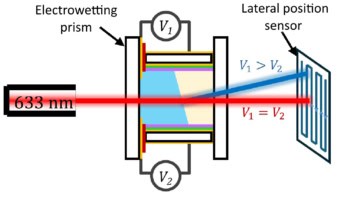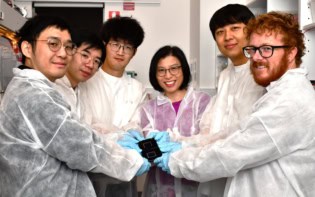The Rainbow Bridge: Rainbows in Art, Myth and Science
Raymond L Lee and Alastair B Fraser
2001 The Pennsylvania State University Press and SPIE Press 393pp $65.00hb
“A single ray of light has a pathetic repertoire, limited to bending and bouncing (into water, glass or air, and from mirrors). But when rays are put together into a family – sunlight, for example – the possibilities get dramatically richer. This is because a family of rays has the holistic property, not inherent in any individual ray, that it can be focused so as to concentrate on caustic lines and surfaces. Caustics are the brightest places in an optical field. They are the singularities of geometrical optics. The most familiar caustic is the rainbow, a grossly distorted image of the Sun in the form of a giant arc in the skyspace of directions, formed by the angular focusing of sunlight that has been twice refracted and once reflected in raindrops.”
This explanation of the rainbow, given by Descartes in 1637, was both a pioneering exercise of computational theoretical physics and the culmination of several millennia of what Raymond Lee and Alastair Fraser call “the slow and convoluted evolution of physical reasoning about the rainbow”.
We learn, for example, how Aristotle – in about 350 BC – understood the rainbow as redirected sunlight, but misunderstood the redirection as mirror reflection from clouds. We learn how Qutb al-Din in Persia and Theodoric in Freiberg, in about 1300, understood the importance of reflection and refraction within individual raindrops but were unable to explain why the light is concentrated near the rainbow angle.
Equally “slow and convoluted” was our understanding of a rainbow’s colours, which culminated (at least at the level of ray optics) with Newton’s incorporation of the spectral dispersion of water into Descartes’ theory. An original feature of the book is the detailed quantification of the colours of several natural rainbows, depicted as curves in the diagram of chromaticity co-ordinates representing hue and saturation. This exercise has the unexpected and startling result that the range of rainbow colours is tiny – less than 5% of the gamut of colours on a TV screen.
Yet this miserable smudge of wan and unsaturated colour “sticks in the popular imagination as a paragon of color variety”. Moreover, although “popular imagination” also envisages the rainbow’s colours as a pure prismatic sequence, Newton’s theory predicts a more complicated pattern, incorporating light far from the caustic and smoothed over the finite angular size of the Sun’s disc.
The Descartes-Newton picture explains much, but fails at a fundamental level by ignoring the wave nature of light. Often the interference fringes in rainbows are obscured by decoherence, but they can sometimes be seen as one or more “supernumerary bows” – a “faintly reproving name, one that has persisted long after we know that they are an integral part of the rainbow, not a vexing corruption of it”.
Lee and Fraser explain in detail how, through Thomas Young’s 1803 analysis in terms of interference, “the supernumerary rainbows proved to be the midwife that delivered the wave theory of light to its place of dominance in the nineteenth century”. Sadly, the authors do not include the celebrated photograph by Roy Bishop that shows a rainbow over the house in Woolsthorpe where Isaac Newton was born. The magnificent irony is that this rainbow shows a clear supernumerary, magnifying the inadequacy of Newton’s theory for all to see, and showing how its ray optics must be replaced by the completely different concepts of wave physics.
Young’s interference theory was itself an approximation. The full diffraction theory of light near a rainbow caustic was developed more than 30 years later by George Airy. I would have liked to see more discussion of this, in particular how the “Airy integral” has proved seminal throughout wave physics – for example in nuclear, atomic and molecular rainbows in quantum scattering involving spherically symmetric interaction potential fields of massive particles. The simple Airy theory gives the canonical description of waves very close to a caustic but incorrectly predicts the positions for the supernumeraries far from the rainbow angle; however, in a development not described here, mathematics from the 1950s enables the Airy integral to be adapted to apply everywhere.
Even Airy’s theory is not the last word, because it neglects polarization effects, which require a full vector-wave analysis based on Maxwell’s electromagnetic equations. This was provided by Gustav Mie’s exact calculation in 1908 of the scattering of light by a homogeneous refracting sphere. Extensive developments by Moyses Nussenzveig in the 1960s uncovered the Airy integral concealed in the intricacies of Mie’s mathematics.
However, as the authors wisely point out, the deeper theories do not necessarily give superior explanations of the natural rainbow. The reason is that their distinctive predictions (for example of the delicate interferences “marbling” the bow) are obscured in practice by the width of the Sun’s disc and by the range of different sizes of raindrops in a shower.
As the book’s title implies, the authors’ ambitions extend well beyond the physics of rainbows. They are aware of at least 150 myths and contradictory religious invocations in which the rainbow is sometimes benign, sometimes ominous. They catalogue the struggles of artists over the centuries to depict the rainbow realistically, often painting the arch in oblique perspective because it was misconceived as an object rather than an image, and – in what seem simple failures of observation – with the elusive colours of this “chameleon of the air” in reverse order.
Lee and Fraser are masters of prose, and their book is sumptuously produced and abundantly illustrated. They are to be congratulated for producing not only a definitive rainbow scholarship but also a gorgeous work of cultural synthesis.




